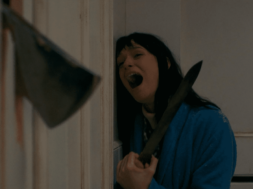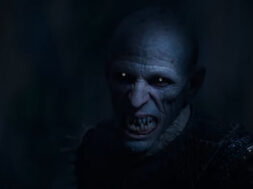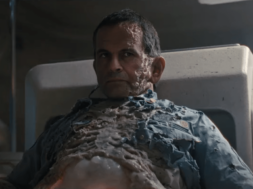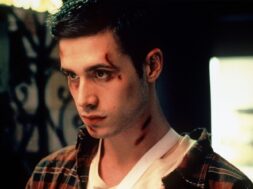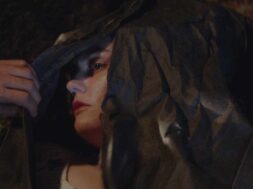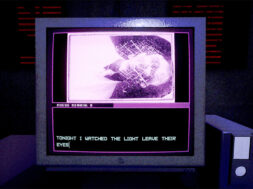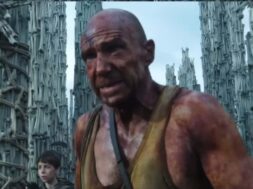July Release ‘The Boy Behind the Door’ Leaves You Breathless and On Edge [Indie Horror Spotlight]
“We need to talk about Gordon,” as Phil (David Caruso) tells Mike (Stephen Gevedon) not long before all hell breaks loose in Session 9.
But before we do, I should mention that this will not be a spoiler-free review but a deeper look into this unnerving cult film. I wouldn’t normally issue a spoiler alert for a twenty-year-old movie, but Session 9 has only slowly gained its audience in the ensuing years since its release. Needless to say, it is a film whose cult I hope only continues to grow. So, with that out of the way…
We need to talk about Gordon. Gordon, played by Peter Mullan, is a quiet, apparently unflappable man with a lovely wife and a brand-new baby daughter, Emma. Sure, his business has hit a rough patch—there is less and less need for asbestos removal—but he seems to have kept his wits about him. As Hank (Josh Lucas) tells Jeff (Brendan Sexton III), Gordon is “the Zen master of calm.” But there’s something about this job.
The Danvers State Mental Hospital is a lot like Gordon. On the outside it is an impressive sight—a massive architectural marvel and not lacking in structural integrity. Like its spiritual cousins Hill House and The Overlook, Danvers “stood so for eighty years and might stand for eighty more.” But like those other landmarks on the landscape of horror, there is something “not sane” about the building itself. Unlike them, the inside of Danvers is rotting, and the cracks are beginning to show. Much like Gordon. Just as Danvers has decayed over time, so has he: slowly, quietly, practically imperceptibly. The building itself is an outward expression of the erosion occurring within his mind, heart, body, and soul.
But Gordon isn’t the only one we need to talk about. Though his actions are the most shocking, he is not the only one affected by Danvers. His unravelling may be the most extreme, but all five men on this crew are gradually being picked apart. For so much of the film, we have no idea which, or if any of them, are responsible for the chaos that will ensue. Even in the end, it is debatable whether or not the responsible party acted alone. All of them are weak. All of them are wounded.
Phil is filled with anger, particularly at Hank. Before the events of the film, Phil’s girlfriend Amy left him for Hank and his rage seethes constantly within him. Hank is greedy and takes what isn’t his even if he doesn’t really want it, even if it makes him miserable. In an early moment, we see that he is not happy in his relationship with Amy, but he stays with her simply out of spite toward Phil. Jeff, Gordon’s nephew, is just young, brash and inexperienced. His flaw is a simple fear: nyctophobia, fear of the dark. But it is an absolutely paralyzing fear.
And then there’s Mike. Mike is something of an enigma. He is incredibly intelligent and, because of that, a distant and cold man. He studied to be a lawyer but chose to work as a laborer, removing asbestos for Gordon’s company instead. In the course of the week at Danvers, he becomes obsessed with listening to a series of reel-to-reel tapes of psychiatric sessions with patient #444, Mary Hobbes, a patient from the early 1970s with what was then called Multiple Personality Disorder. He often sneaks away from the job at hand to listen to the tapes labeled Session 1-9. He notes the various personalities exhibited on the tapes and analyzes them for meaning throughout the film.
Mike is also a fount of information, letting us in on some of the history surrounding Danvers, institutions, and the deinstitutionalization movements of the early 1980s. The real stories of Danvers are woven into the fabric of Session 9’s plot, giving a sense of semi-documentary to elements of the proceedings. Though only tangential to the plot, Mike’s story of Patricia Willard (a fictional story created to illustrate a real trend) makes an important thematic point. It deals with the controversial subject of Satanic Ritual Abuse, the retrieval of repressed memories, and the questionable credibility surrounding such stories and practices.
This all brings us to the central questions of the film. Where does evil come from? Is it an external force that influences and compels? Or does it come from the human heart of darkness? These are similar to questions asked in The Shining. Is it The Overlook that drives Jack toward murder, or was the drive already in him, exacerbated by frustrations over his writer’s block, alcoholism, and cabin fever? In another thread of connection, it is interesting to note that both Jack Torrance and Gordon have wives named Wendy—one of them escapes, the other does not.
Making the case that evil comes from the outside is the fact that Gordon hears a mysterious voice when he first tours Danvers. This voice is later revealed to be “Simon,” one of the personalities of Mary Hobbes heard for the first time on the tape labeled Session 9. Is evil somehow within the walls of Danvers itself? Is “Simon” some kind of ancient entity that seeks out “the weak and the wounded” and forces their hands to kill and destroy? On the tape, the doctor asks, “why did you do it Simon?” referring to Mary killing her family. “Because Mary let me, doc. They always do.” This ambiguous answer leads to the second, and perhaps more frightening possibility, that evil comes from within.
Perhaps under all that calm, Gordon was already hiding malice in his heart that he refused to address or denied even existed. When Gordon confesses to Phil that he slapped his wife on the evening they got the Danvers job, he is unable to admit the full reality of the situation. He had come home with a bottle of champagne to celebrate, but when he leaned in the kiss her hello, a pot of boiling water on the stove fell on him, severely burning his leg. “I don’t know if it was the dog barking. I don’t know if it was Emma crying, but I slapped her.” He adds, dismayed and barely believing his actions, “I hit my wife. I love my wife. It was an accident. But I slapped her for it.” We soon learn that he did far more than that.
So, just what was it that got into Gordon? The film lets us decide. That is one of the beauties of Session 9—the ambiguity. It can be viewed through the lens of supernatural horror: a dark, creeping dread with spirits and ghosts in the tradition of The Innocents (1961) or The Haunting (1963). On the other hand, the film can be viewed as completely naturalistic with the darkness of human psychology as the true villain.
The craft of the film underscores the tensions of its themes. It was an early movie to be shot on HD rather than film but looks much better than many movies shot in the format at the time. Director Brad Anderson and Director of Photography Uta Briesewitz makes great use of natural and available light as well as the dark, claustrophobic corridors of their location, making Session 9 an unusual mix of bright daylight horror and oppressive, gloomy atmosphere. Dialogue scenes and monologues are intercut with images of the peeling paint and crumbling structures of Danvers or the dying grass and buzzing insects on the grounds. The sound design and music only add to the spare nature of the story and visuals. The score is unlike anything found in horror films of the period, which generally came from either the Bernard Herrmann Psycho tradition or the synth laden John Carpenter/Alan Howarth school. The Climax Golden Twins (Robert Millis and Scott Colburn) created a score drawn from the sparse, found sound tradition of John Cage and other mid-20th century composers. It is something akin to the atonal music used in the original Texas Chain Saw Massacre, which lies somewhere between score and sound design with the two often blending into each other.
Session 9 is very different from anything else that was coming out of horror cinema at that time. It was the era of J-horror, big budget films like Hannibal and The Others, and the tail end of the Scream imitators. Because of this, the distributor, USA Films, didn’t really know what to do with it. Today, Session 9 surely would have been snatched up in a heartbeat by A24, SpectreVision, or some other likeminded independent studio. Instead, it was forced to take the long road of the cult movie: obscurity, gradual discovery, and “scariest movies you’ve never seen” lists. The film was released in a couple of small theaters in August of 2001 but quickly disappeared. It was slowly discovered on DVD in the last years of rental stores and the heyday of DVD Netflix. Today, it enjoys true cult status as one of the most unsettling movies of the century so far.
It is a distinction that Session 9 is worthy of receiving, at least from those who have seen it. It is a film of constantly encroaching dread, deliberately paced but constantly engaging. It creeps, almost undetected, under the skin and lingers. It is a rare movie that somehow manages to get scarier upon repeat viewings. The more often the film is viewed, the more details are noticed. The more details are noticed, the more the Devil that dwells in them is revealed.
